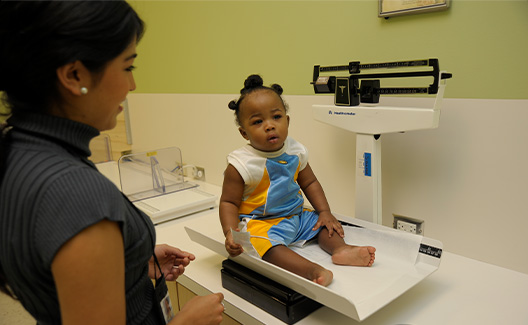In the first few weeks, breastfed infants typically regain birth weight at an average of 8.3 days postpartum (95% confidence interval: 7.7–8.9 days) with 97.5% having regained their birth weight by 21 days (ABM Protocol #3). Before determining if interventions are needed, it is important to evaluate each newborn individually according to his or her health status, age, birth circumstances and interventions, activity level, development, family traits and other individual considerations. Conducting a thorough feeding assessment and history is important when determining if supplementary management for infant weight loss, slow or poor weight gain is needed.
Infant Weight Concerns

Inconsistent information in the early days and weeks of breastfeeding or lack of continuity in care after facility discharge are key factors of breastfeeding mismanagement to consider when initially assessing an infant’s poor weight gain. Mismanagement can include improper positioning and latch, low frequency or duration of feedings, strict or timed feeding schedules, absence of night feedings and separation of mother and infant, among others.
Additional factors for infant weight loss include:
- Neonatal jaundice or yellowing of the skin
- Premature birth
- Trisomy 21
- Trisomy 13-15
- Hypothyroidism
- Neuromuscular dysfunction (torticollis, nerve impairment due to birth trauma, other)
- Central nervous-system impairment
- Cardiac or respiratory problems
- Anatomical challenge (tongue or lip tie, etc.)
- Maternal medications that can impact milk supply include:
- estrogen containing products (e.g. oral contraceptives) and estrogenic medications, pseudoephedrine, methylergonovine, cabergoline, possibly bupropion, and progestin-only contraceptives before 6 weeks postpartum in some women.
- narcotic analgesia or anesthesia which can diminish the infant's alertness and ability to suck (specifically meperidine).
For additional information on maternal contributing factors, review the Low Milk Supply Section.
Weight should not differ from standard growth curves between 3 weeks and 3 months of life for either breastfed or formula-fed infants. Infant growth should be tracked using the growth charts listed below:
- Growth Charts - monitor growth for children age 2 years and older in the U.S.
The breastfeeding infant is alert and healthy, with good tone, good skin turgidity, many wet and stool diapers, pale and diluted urine, more than 8 feedings per day and positive weight gain (½ ounce or more per day).
After 3 months of age, the normal growth of exclusively breastfed infants may differ slightly from that of formula-fed infants with respect to weight and length. However, there are no differences in head circumference growth.

It is important to remember:
- It is well studied that breastfed infants have a reduced risk of obesity and obesity related diseases such as diabetes, cardiovascular disease and certain cancers. This may be attributed to the greater degree of adiposity seen in formula-fed infants.
- Slower growth among breastfed infants during ages 3-18 months is normal.
- Weight gain in formula-fed infants may be abnormally fast, especially between 3-6 months of age.
- Breastfed infants are leaner than formula-fed infants, with the difference in adiposity most evident at 9-12 months
In the infant, assess for:
- Mother-infant separation, pacifier use, water or juice supplementation or early introduction of solid food.
- Possibility of poor suckling due to cleft lip or palate, short frenulum, micrognathia, macroglossia or choanal atresia.
- Malabsorption, vomiting, diarrhea and infection in the infant.
In the mother, assess for:
- Lack of glandular tissue or development. The mother may report little to no breast change during pregnancy and postpartum; possibly marked differences in shape of breasts (e.g. tubular shaped or widely spaced breasts) or have a history of previous breast surgery to correct uneven breast development.
- Infection, Hypothyroidism, Obesity, untreated Diabetes, Sheehan's syndrome, pituitary disease, mental illness, fatigue and emotional disturbance.
- Severe diet restriction, smoking and alcohol use.
- History of breast surgery (assess for type of surgery and scars). Breast reduction and peri-areolar incisions have more potential for supply concerns.
- New pregnancy or retained placental fragments.
- Observe a breastfeeding session using both the infant’s pre- and post-feeding weight to determine if there is effective milk transfer. Discuss the mother’s feeding goals and mental health status when developing feeding plan. Consider supplementation at the breast using mother’s own expressed breastmilk, banked donor milk or formula.
- Schedule frequent and close follow-up for weight check and feeding assessment.
- Refer the mother to a Lactation Consultant or include one in your care team so that a well-rounded feeding plan can be developed.
- If the baby is actively feeding from the breast:
- Suggest skin-to-skin contact, hand expression and breast massage before feedings to aid with increased circulation and milk flow to the baby.
- Ensure feeding frequency is more than 8-12 times in 24 hours. Encourage mom to keep intake/output log if the infant is less than 7 days old.
- Encourage feeding on both breasts at every feeding.
- Help her use breast compressions during feedings to increase milk flow to the baby.
- If the baby is not latching:
- If <48 hours post birth, hand expression is the best method for removing colostrum and stimulating the milk supply.
- If >48 hours post birth, use a hospital grade electric breast pump to remove the milk for the baby.
- Apply warm compresses and massage before pumping.
- Use breast compressions during pumping to increase fat content.
- Feed the baby with an alternative method (e.g. cup, spoon, at- breast lactation aid) if the mother is able to manage or recommend bottle-feeding until transitioned to the breast. Provide the family with information on safe bottle preparation and paced bottle-feeding.
- Continue using breast pump to maintain her milk supply until the baby has fully transitioned to the breast and baby’s weight has normalized.
- Encourage parents to document the infant’s feeding frequency, wet diapers and stools.
- Consider a referral to an occupational or speech therapist for suck and swallow evaluation.
- Connect mother with community-based support group for additional breastfeeding support.
Clinical Guidelines
- Grawey, A. E., Marinelli, K. A., Holmes, A. V., & Academy of Breastfeeding Medicine (2013). ABM clinical protocol #14. Breastfeeding-friendly physician’s office: optimizing care for infants and children, revised 2013. Breastfeeding Medicine, 8, 237–242.
- Kellams, A., Harrel, C., Omage, S., Gregory, C., & Rosen-Carole, C. (2017). ABM Clinical Protocol #3: Supplementary Feedings in the Healthy Term Breastfed Neonate, Revised 2017. Breastfeeding Medicine, 12, 188–198.
- Taylor, S. N. (2018). ABM Clinical Protocol #29: Iron, Zinc, and Vitamin D Supplementation During Breastfeeding. Breastfeeding Medicine, 13(6), 398–404.
References
- Campbell, S. H., Lauwers, J., Mannel, R., & Spencer, B. (2019). Core curriculum for interdisciplinary lactation care. Jones & Bartlett Learning.
- Hassiotou, F., Hepworth, A. R., Williams, T. M., Twigger, A. J., Perrella, S., Lai, C. T., Filgueira, L., Geddes, D. T., & Hartmann, P. E. (2013). Breastmilk cell and fat contents respond similarly to removal of breastmilk by the infant. PloS One, 8(11), e78232.
- Lawrence, R. A., & Lawrence, R. M. (2016). Breastfeeding: A guide for the medical profession (8th ed.). Elsevier.

